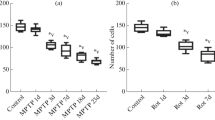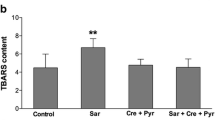Abstract
Methylmercury chloride was administered PO to male Kud: ddY mice at a dose of 5 mg/kg/day for 20 days. The contents of taurine, aspartate, glutamate, glycine, and γ-aminobutyric acid were determined in tissue and crude synaptosomal (P2) fraction of cerebellum, cerebral cortex, and spinal cord of methylmercury-treated mice with or without ataxia. In the cerebellum of ataxic mice, increased levels of taurine and glycine were found in the tissue and P2 fraction, and increased levels of glutamate were found in the P2 fraction. In the cerebral cortex, the levels of γ-aminobutylic acid decreased in the tissue and in the P2 fraction of ataxic mice, but increased levels were found in the tissue of non-ataxic mice. A decreased aspartate level in the cerebral cortex of ataxic mice and an increased taurine level in the cerebral cortex of non-ataxic mice were also found. In the spinal cord of ataxic mice, taurine increased in the tissue and in the P2 fraction. Glutamate level decreased in the spinal cord of ataxic mice, but increased in the P2 fraction of non-ataxic mice. Increased glycine levels in the P2 fraction of the spinal cord were also found in non-ataxic mice. Histologically, some degenerative changes were demonstrated in the cerebral and cerebellar cortices of ataxic mice. Such changes were also present to a mild degree in non-ataxic mice. In conclusion, methylmercury treatment altered the levels of putative neurotransmitter amino acids in neural tissue of mice. These alterations might be caused by specific neural cell dysfunction and could be related to the appearance of ataxia.
Similar content being viewed by others
References
Aprison MH, Daly EC (1978) Biochemical aspects of transmission at inhibitory synapses: The role of glycine. In: Agranoff BW, Aprison MH (eds) Plenum Press, New York London (Advances in neurochemistry vol. 3, pp 203–294
Barbeau A, Tsukada Y, Inoue N (1976) Neuropharmacological and behavioral effects of taurine. In: Huxtable R, Barbeau A (eds) Raven Press, New York pp 253–266
Caviness VS Jr (1975) Architectonic map of neocortex of the normal mouse. J Comp Neurol 164: 247–264
Charbonneau SM, Munro IC, Nera EA, Willes RF, Kuiper-Goodman T, Iverson F, Moodie CA, Stoltz DR, Armstrong FAJ, Uthe JF, Grice HC (1974) Subacute toxicity of methylmercury in the adult cat. Toxicol Appl Pharmacol 27: 569–581
Dichter MA (1980) Physiological identification of GABA as the inhibitory transmitter for mammalian cortical neurons in cell culture. Brain Res 190: 111–121
Doi R, Kobayashi T (1982) Organ distribution and biological half-time of methylmercury in four strains of mice. Jpn J Exp Med 52: 307–314
Doi R, Tagawa M, Tanaka H, Nakaya K (1983) Hereditary analysis of the strain difference of methylmercury distribution in mice. Toxicol Appl Pharmacol 69: 400–406
Doi R, Tagawa M (1983) A study on the biochemical and biological behavior of methylmercury. Toxicol Appl Pharmacol 69: 407–416
Freeman ME, Lane JD, Smith JE (1983) Turnover rates of amino acid neurotransmitters in regions of rat cerebellum. J Neurochem 40: 1441–1447
Frederickson R, Jordan L, Phillis J (1971) The action of noradrenaline on central neurons. Brain Res 35: 556–560
Foster AC, Roberts PJ (1980) Morphological and biochemical changes in the cerebellum induced by kainic acid in vivo. J Neurochem 34: 1191–1200
Gray EG, Whittaker VP (1962) The isolation of nerve endings from brain: An electronmicroscopic study of cell fragments derived by homogenation and centrifugation. J Anat 96: 79–88
Hendrickson AE, Hunt SP, Wu J-Y (1981) Immunocytochemical localization of glutamic acid decarboxylase in monkey striate cortex. Nature 292: 605–607
Hirdina PD, Peters DAV, Singhal RL (1976) Effects of chronic exposure to cadmium, lead and mercury on brain biogenic amines in the rat. Res Commun Chem Pathol Pharmacol 15: 483–493
Hoskins BB, Hupp EW (1978) Methylmercury effects in rat, hamster, and squirrel monkey. Environ Res 15: 5–19
Inouye M, Oda S (1980) Strain-specific variations in the folial pattern of the mouse cerebellum. J Comp Neurol 190: 351–362
Ishida F (1970) The changes of glutamic acid decarboxylase (GAD) and γ-aminobutyric acid (GABA) determination in the brain of the methylmercury poisoning animals. J Kumamoto Med Sci 44: 648–652
Juang MS, Yonemura K (1975) Increased spontaneous transmitter release from presynaptic nerve terminal by methylmercury chloride. Nature 256: 211–213
Johnson E, Roberts M, Sorbezak A (1969) Noradrenaline cells in the cat cerebral cortex. Br J Neuropharmacol 8: 549–566
Kobayashi H, Yuyama A, Matsusaka N, Takeno K, Yanagiya I (1980) Effect of methylmercury chloride on brain acetylcholine concentration and turnover in mice. Toxicol Appl Pharmacol 54: 1–8
Konagawa M, Takayanagi T, Muroga T, Adachi K, Sobue I (1980) Noradrenaline metabolism in the brain of Rolling mouse Nagoya and the influence of thyrotropin releasing hormone. Clin Neurol 20: 181–188
Krnjevic K, Schwartz S (1967) The action of γ-aminobutyric acid on cortical neurons. Exp Brain Res 3: 320–326
Landis SC, Schemaker WJ, Schulumpf M, Bloom FE (1975) Catecholamines in mutant mouse cerebellum: fluorescence microscopic and chemical studies. Brain Res 93: 253–266
McBride WJ, Aprison MH, Kusano K (1976) Contents of several amino acids in the cerebellum, brain stem and cerebarum of the “staggerer”, “weaver”, and “nervous” neurologically mutant mice. J Neurochem 26: 867–870
Muramoto O, Kanazawa I, Ando K (1981) Neurotransmitter abnormality in rolling mouse Nagoya, an ataxic mutant mouse. Brain Res 215: 295–304
Nadi NS, McBride WJ, Aprison MH (1977) Distribution of several amino acids in regions of the cerebellum of the rat. J Neurochem 28: 453–455
Nordberg GF, Skerfving S (1972) Metabolism in mercury in the environment. In: Friberg L, Vostal D (eds) CRC Press, Cleveland Ohio, pp 29–91
Oja SS, Kontro P (1983) Free amino acids in epilepsy: Possible role of taurine. Acta Neurol Scand, Suppl 93: 5–20
Okada Y, Nitsch-Hassler C, Kim JS, Bak IJ, Hassler R (1971) Role of γ-aminobutyric acid (GABA) in the extrapyramidal motor system. I. Regional distribution of GABA in rabbit, rat, guinea pig and baboon CNS. Exp Brain Res 13: 514–518
Okuda J, Tsuzuki Y, Yamada T (1978) Some neurological changes in the brain of rats with acute intoxication of methylmercuric chloride. Jpn J Legal Med 32: 51–58
Prasad KN, Harrington ME, Bondy SC (1979) Effects of methylmercuric chloride on high affinity uptake of certain putative neurotransmitters in neuroblastoma and glioma cultures. Toxicol Lett 4: 373–377
Rea MA, McBride WJ, Rohde BH (1981) Levels of glutamate, aspartate, GABA and taurine in different regions of the cerebellum after X-irradiation-induced neuronal loss. Neurochem Res 6: 33–39
Roffler-Tarlov S, Sidman RL (1978) Concentration of glutamic acid in cerebellar cortex and deep nuclei of normal mice and weaver, staggerer and nervous mutants. Brain Res 142: 269–283
Schon F, Iverson LL (1972) Selective accumulation of [H3]GABA by stellate cells in rat cerebellar cortex in vivo. Brain Res 42: 503–507
Shank RP, Graham LT Jr (1978) The multiple roles of glutamate and aspartate in neural tissues. In: Agranoff BW, Aprison MH (eds) Plenum Press, New York London (Advance in neurochemistry, vol 3, pp 165–202)
Takeuchi T (1968a) Pathology of Minamata disease. In: Kutsuna M (ed) Study group of Minamata disease, Kumamoto University, Japan, pp 141–228
Takeuchi T (1968b) Experiments with organic mercury, particularly with methylmercury compounds; Similarities between experimental poisoning and Minamata disease. In: Kutsuna M (ed) Study group of Minamata disease, Kumamoto University, Japan, pp 229–252
Takeuchi T (1982) Pathology of Minamata disease with special reference to its pathogenesis. Acta Pathol Jpn 32: 73–99
Taylor LL, DiStefano V (1976) Effects of methylmercury on brain biogenic amines in the developing rat pup. Toxicol Appl Pharmacol 38: 489–497
Tran VT, Synder SH (1979) Amino acid neurotransmitter candidates in rat cerebellum: Selective effect of kainic acid lesions. Brain Res 167: 345–353
Tsuzuki Y (1982) Effect of methylmercury exposure on different neurotransmitter system in rat brain. Toxicol Lett 13: 159–162
Turecky L, Liska B, Pechán I (1980) Glycine in the central nervous system in experimental allergic encephalomyelitis. J Neurochem 35: 735–738
Von Burg R, Northington FK, Shampoo A (1980) Methylmercury inhibition of rat brain muscarinic receptors. Toxicol Appl Pharmacol 53: 285–292
Webb JL (1966) Mercurials. In: Webb JL (ed) Academic Press, New York London (Enzyme and metabolic inhibitors, vol 2, pp 729–1070
Young AB, Oster-Granite, ML, Herndon RM, Synder SH (1974) Glutamic acid: Selective depletion by viral induced granule cell loss in hamster cerebellum. Brain Res 73: 1–13
Author information
Authors and Affiliations
Rights and permissions
About this article
Cite this article
Hirayama, K., Inouye, M. & Fujisaki, T. Alteration of putative amino acid levels and morphological findings in neural tissues of methylmercury-intoxicated mice. Arch Toxicol 57, 35–40 (1985). https://doi.org/10.1007/BF00286572
Received:
Accepted:
Issue Date:
DOI: https://doi.org/10.1007/BF00286572




